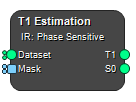T1 Estimation

Calculate a T1 map using spin echo inversion recovery (IR) data. The input must be a multi-channel image, where each volume has an associated flip angle (FA) and repetition time (TR). At least two volumes are required, however, more are advised if a larger range of T1 values are expected. Flip angle (FA) and repetition time (TR) can be supplied via the metadata for each volume, or as input numerical arrays. An optional mask can also be provided to limit the calculations to a region of interest.
Produces a T1 map in the same units as TR, and \(\text{S}_0\) which is a proton and T2 weighted image. The parameter values are obtained by fitting the data to the signal equation:
where \(n\) is the number of images used.
Inputs
Dataset
An image or a list of images (for batch processing) where channel dimensions are used for the different \(TI\) values. At least two volumes are needed and they should have the same \(TR\) and echo time.
Type: Image, List, Required, Single
Mask
Mask(s) used to confine the region in which the signal model is fitted.
Type: Mask, List, Optional, Single
Outputs
T1
The estimated \(T1\) parameter map.
Type: Image, List
S0
The estimated \(S_0\) parameter map.
Type: Image, List
Settings
Configure
IR Method Selection
The type of signal model used, i.e. whether it is the real signal (Phase Sensitive) or magnitude signal that has been measured.
Values: Phase Sensitive, Magnitude
Batch Size Integer
The number of voxels that are computed per batch. This is a trade-off between performance and memory consumption.
Keep Metadata Boolean
Keep or discard metadata in the parameter maps.
Configure NonLinear
Tolerance Float
The threshold change in the objective function. Changes smaller than this value imply that the fitting has converged.
Max Iterations Integer
Maximum number of iterations.
Return Convergence Map Boolean
Return a binary mask, where all true voxels have converged in the fit. This can be used to exclude voxels that did not converge.
Metadata
Repetition Time Source Selection
Select the \(TR\)-value source for the calculation. The \(TR\)-values can be taken from the metadata, or can be supplied as an input Numeric Array.
Values: Metadata, Numeric Array Input
Inversion Time Source Selection
Select the \(TI\)-value source for the calculation. The \(TI\)-values can be taken from the metadata, or can be supplied as an input Numeric Array.
Values: Metadata, Numeric Array Input
Repetition Time Tag Text
The \(TR\)-value tag name in the metadata.
Inversion Time Tag Text
The \(TI\)-value tag name in the metadata.
See also
Keywords:
Copyright © 2025, Hero Imaging AB
